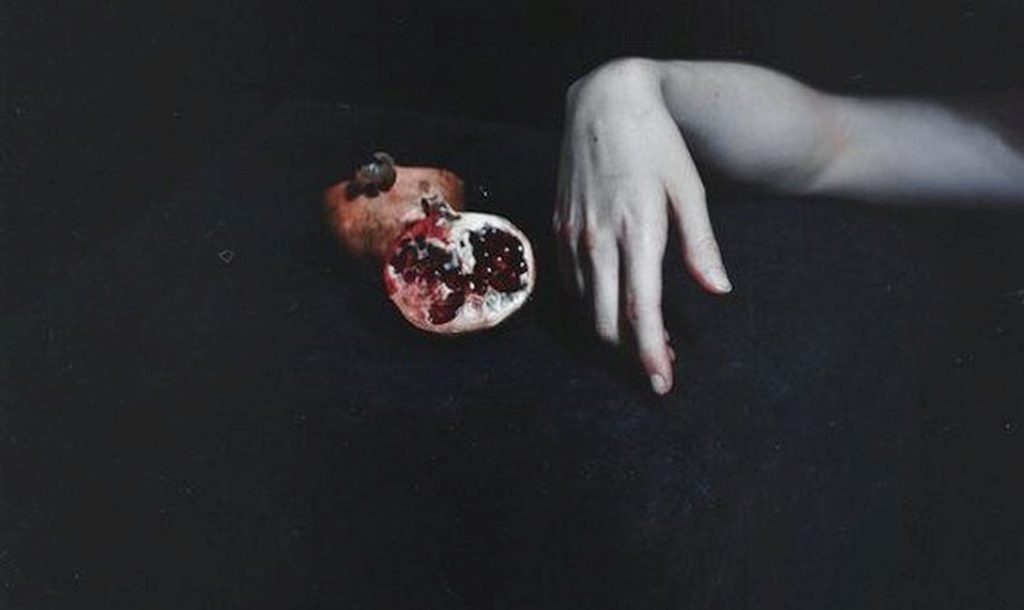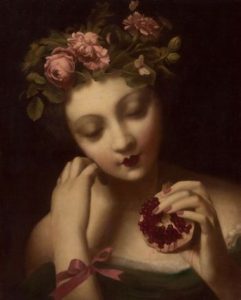by Ellie Pierpoint
Right about now the Eleusinian Mysteries would be taking place in Greece.
These ancient rituals celebrate the myth of Persephone and her journey into the underworld and the subsequent changing of the seasons, but as with all myths, there’s a deep psychological reflection to be told too.
Persephone’s journey to the underworld
So, let’s start with the myth:
The Greek Goddess of fertility and agriculture, Demeter, had a daughter, Persephone (or Kore, ‘the maiden’) who was very beautiful. She was so lovely that the lord of the underworld, Hades (or Pluto), took a particular shine to her.
One day when Persephone was out frolicking in the fields (as Goddesses do), Hades planted a narcissus flower for her to find.
When Persephone smelt the flower, she was whisked away to the underworld to become Hades’ undead bride (who said chivalry is dead?).
Meanwhile back up on earth, Demeter searched all over for her daughter, neglecting her duties as the Goddess of fertility and agriculture and letting the crops wither and die.
The humans suffered with no crops and pretty soon the rest of the Gods and Goddesses got involved, since they hadn’t seen a decent sacrifice in a while and were feeling pretty miffed about it.
Zeus finally convinced Hades to give Persephone back to her mother, but before she left the underworld she was tricked into eating forbidden pomegranate seeds, ensuring that she would have to return to the underworld for a few months of every year.
These months when Persephone was in the underworld would cause Demeter to mourn for her daughter and let the crops die again.
This is basically an allegory for the changing of the seasons – when Persephone goes down into the earth, so do the plants, and the autumn leaves falling is represented as our trip into the darkness of the underworld.
When Persephone returns in spring, so do the plants and flowers – but there’s more to this myth than meets the eye.
The narcissus flower
Though a lot of renditions of this story tend to miss this tiny detail, it’s actually a vital part of the myth. The flower that Persephone smells is named after Narcissus, and you can probably guess what he was like!
The myth of Narcissus tells that he was under a curse of sorts which promised him eternal life, as long as he abided by one rule (there’s always a catch huh) – he was never to know his true self.
One day while drinking from a spring, he caught a reflection of himself, and being a pretty fine looking young fellow, promptly fell in love with himself (don’t they all!).
Unable to come to terms with the fact that he could never truly have what he saw (himself), he rather dramatically went and killed himself.
Adam and Eve’s fall from grace
So how does this tie in with our story of Persephone and the changing of the seasons you may be asking?
Well, this myth has some very suspicious similarities with the story of Adam and Eve and their banishment from Eden after tasting the forbidden fruit of knowledge.
And what is this knowledge then, that when someone sees themselves they get so overwhelmed that they ‘fall from grace’, if only knowledge of the Self? Or gnosis, as the ancient Gnostics called it.
When Narcissus saw himself, and I mean really saw, much deeper than the metaphor of looking into a reflective surface, he saw his true Self, his soul.
He was not ready for that kind of big and scary revelation and so took his own life, just as his curse had foretold.
When Adam and Eve tasted the fruit of self-knowledge, they became full of shame and self-consciousness, sent naked and cold from the paradise of God’s back garden. They were not ready either.
So back to our lovely Persephone, that fleeting mention of the Narcissus flower then is a clue that Persephone became aware of herself.
She saw her own beauty, and her own darkness too. Shame and lust and envy and glutton – all the nasty naughty sides of her psyche that she, like everyone else, is desperate to disown.
Each of these characters pays the price for their knowledge by a fall into darkness, perhaps not the literal fall into an underworld, death or banishment, but an encounter with the Shadow side of their psyche.
The encounter with shadow
Interestingly, the story of Persephone is somewhat different to the others because she survives this encounter with her Shadow side and lives to tell the tale.
She spends a number of months in darkness; the eternal hellfire and suffering of “the underworld” or more literally, her own hidden madness.
But instead of dying or living in shame like Narcissus or Adam and Eve, Persephone learns to balance this dark side with the light (like a true witch).
Persephone stays in the underworld as long as necessary, coming up out of the earth when the time is right to give the world life and growth.
She has accepted her Shadow Self, her connection to darkness, and integrated it to achieve wholeness.
Cool story huh? But what does it have to do with me? You may ask.
Well, aside from the glaringly obvious fact that we could all do with accepting the icky, dark, crazy parts of ourselves if we’re going to survive a journey of self-knowledge, also the seasons have just changed, and if you’re up on the Northern Hemisphere like I am, you’ll be experiencing the equinox and be getting ready to enter the dark time of winter.
Winter is a time of hibernation, the seeds are yet to be planted ready for next year’s harvest and Persephone sleeps down below in the underworld.
Like the myths, we can choose to let this cold season of the soul overtake us and deliver us into madness, or we can learn to come to terms with the darkness inside ourselves.
I find that this cold half of the year is a time of reflection (though not quite in the way Narcissus went about it).
We can safely dig into our psyche and see if there is anything there that needs healing and accepting, ready to emerge again whole for springtime.
Summer is all about warmth, distraction, fun and masculine drive and energy, but winter is the time of The Crone, a time for wisdom and transformation.
Everything dies but will awaken again next year.
Perhaps this is a time to embrace your cold rejected parts, the parts you push down into the underworld of your unconscious, and stay with them for a time until you’re ready to truly own them and return into the light.
When you encounter your darkest reflection, will you allow yourself to accept it?
IN CONCLUSION
If this essay resonates with you, please join our WITCH email list by using the forms on this website so we can stay in touch.
About the Author:
featured image source


